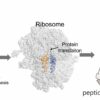The epidemic of opioid abuse affects millions of people worldwide, but researchers know surprisingly little about the molecular changes caused by opioids in the human brain. A new study, which appears in Biological Psychiatry, aims to better understand those molecular events; showing that genes are expressed differently in the brains of people with opioid use disorder (OUD) compared to those not using opioids.
“These changes may explain not only the addictive properties of opioids but what ultimately causes harm to the brain and the person suffering with opioid use disorder,” said Ryan Logan, Ph.D., an Associate Professor at Boston University’s School of Medicine, Boston, MA, U.S. and senior author of the study.
“These gaps in our understanding of opioids’ actions in the brain limits our ability to develop more effective therapies,” Dr. Logan explained. “To address this, we employed new methods to identify novel molecular playersdirectly in the brains of people who struggled withopioid use disorder.”
Dr. Logan and his team obtained autopsy brain tissue from 20 subjects with OUD and chronic opioid use, and 20 without a history of opioid use. To identify differing patterns of gene expression, they used RNA sequencing (RNAseq), a technique that reflects how strongly genes are being expressed in a given tissue. RNAseq of the dorsolateral prefrontal cortex and the nucleus accumbens, two brain areas strongly associated with addiction pathophysiology, showed that certain genes were expressed differently in people with OUD compared to controls. The affected genes fell into two broad categories: genes encoding proinflammatory immune molecules; and those involved in remodeling of the extracellular matrix, which suggests that connections between neurons may have been altered by opioid use. The results also indicated that the brain’s resident immune cells, called microglia, were present at higher levels in the brains of people with OUD.
“We discovered several important molecular pathways that are integral in mediating the consequences of chronic opioid use on the brain. These molecules are responsible for shaping and maintaining the local environment required for neurons to function properly, as well as molecules critical for local inflammation that may impact the brain’s response to opioids. Together, these players represent new targets in both the pathology and treatment of opioid use disorder,” said Dr. Logan.
John Krystal, MD, Editor of Biological Psychiatry, said of the study: “The deeper we understand opioid use disorders, the more complex is the biology that emerges. This study highlights that opioid dependency is associated with expected changes in markers of neural response and plasticity, but also with neuro-inflammatory changes associated with microglia. These findings suggest important new directions that can be followed in larger studies and that broaden our view of the neurobiology, and potentially treatment, of opioid use disorder.”
Inflammatory process alteration accompanies opioid use disorder
More information:
Marianne L. Seney et al, Transcriptional Alterations in Dorsolateral Prefrontal Cortex and Nucleus Accumbens Implicate Neuroinflammation and Synaptic Remodeling in Opioid Use Disorder, Biological Psychiatry (2021). DOI: 10.1016/j.biopsych.2021.06.007
Citation:
Brain gene expression patterns altered by chronic opioid use (2021, August 13)
retrieved 15 August 2021
from https://medicalxpress.com/news/2021-08-brain-gene-patterns-chronic-opioid.html
This document is subject to copyright. Apart from any fair dealing for the purpose of private study or research, no
part may be reproduced without the written permission. The content is provided for information purposes only.



